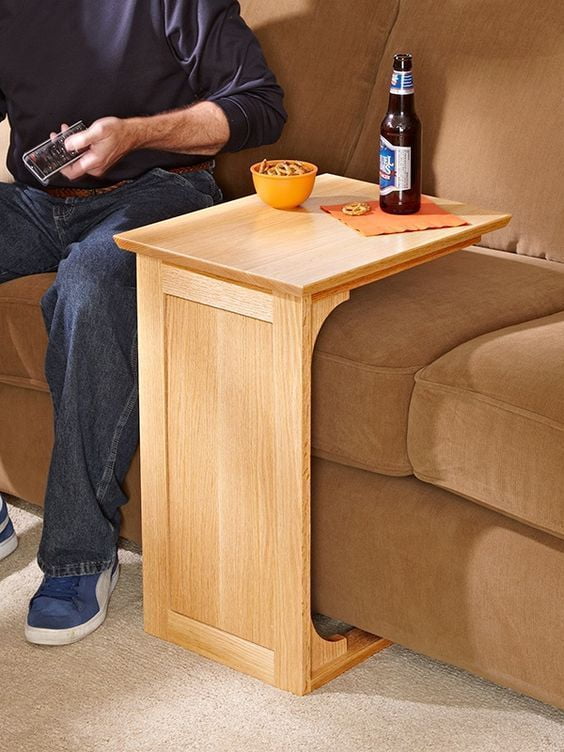What tools are needed for woodworking? Whether you are a beginner or an experienced woodworker, having the right tools is essential for creating high-quality woodcrafts. In this article, we will delve into the basics of woodworking and explore the various tools required to bring your woodworking projects to life.
Woodworking is a skilled craft that involves shaping and creating items from wood. Understanding the fundamentals of woodworking is crucial before diving into your first project. This includes learning about the different types of wood, understanding grain patterns, and knowing which tools are necessary for specific tasks. With the right knowledge and tools, you can transform raw wood into beautiful furniture, intricate carvings, and other impressive creations.
In the following sections, we will examine the essential hand tools for woodworking, the importance of power tools such as table saws and routers, measuring and marking tools, safety equipment, specialized woodworking tools like carving instruments and specialty clamps, as well as sharpening and maintenance tools. By gaining insights into each category of woodworking tools, you will be well-equipped to embark on your woodworking journey with confidence.
Essential Hand Tools for Woodworking
Woodworking is a rewarding and fulfilling hobby or profession, but it requires the right tools to be successful. When starting out in woodworking, it’s important to have the essential hand tools at your disposal. Here is a detailed overview of the most crucial hand tools that every woodworker should have in their workshop:
1. Chisels: Chisels are an indispensable tool for any woodworker. They are used for cutting, shaping, and carving wood to create intricate designs or smooth surfaces. A set of high-quality chisels in different sizes is necessary to tackle various woodworking projects.
2. Hand Saws: Hand saws are essential for making precise cuts in wood. There are different types of hand saws including crosscut saws, rip saws, and dovetail saws, each designed for specific cutting tasks.
3. Hand Planes: Hand planes are used to smooth and flatten surfaces of wood. They come in various sizes and types, such as block planes, smoothing planes, and jack planes, each serving a unique purpose in woodworking projects.
In addition to these three essential hand tools, other necessary items for woodworking include a mallet, layout tools such as marking knives and bevel gauges, as well as files and rasps for shaping and smoothing wood surfaces. These hand tools are indispensable for any woodworker looking to create high-quality woodcrafts.
It’s incredibly important that you use quality materials when looking into what tools are needed for woodworking. Quality things equal quality results – something that any skilled craftsman knows.
Power Tools for Woodworking
Woodworking power tools are essential for any woodworker looking to create high-quality, professional-level projects. These tools greatly increase efficiency and precision, allowing for faster and more accurate cuts, shaping, and drilling. Here are some of the most important power tools needed for woodworking:
- Table Saw: A table saw is a fundamental power tool for woodworking. It is used for making straight cuts on large pieces of wood, and it can also be equipped with different blades for various cutting purposes.
- Miter Saw: A miter saw is perfect for making angled cuts, whether it’s a simple straight cut or more complex angled cuts such as bevels and compound angles. This versatile tool is a must-have for any woodworker.
- Router: Routers are used to hollow out an area in a piece of wood or to create intricate designs and patterns. They can also be used with various bits to create decorative edges and joints.
- Drill: A drill is essential for creating holes in wood, whether it’s for simple joinery or attaching hardware to your projects. Cordless drills provide flexibility and freedom of movement without sacrificing power.
Having these power tools in your workshop will allow you to tackle a wide range of woodworking projects with ease. Whether you’re building furniture, crafting cabinets, or creating intricate wooden decorations, these power tools are indispensable.
Investing in high-quality power tools not only improves the quality of your work but also makes the woodworking process safer and more efficient. When considering what tools are needed for woodworking, these power tools should be at the top of every woodworker’s list.
Measuring and Marking Tools for Woodworking
Measuring and marking tools are essential for woodworking as they ensure precision and accuracy in every project. Whether you are a beginner or an experienced woodworker, having the right measuring and marking tools is crucial for creating high-quality woodcrafts. In this section, we will delve into the significance of tape measures, marking gauges, and combination squares in the woodworking process.
Tape Measures
Tape measures are versatile and indispensable tools in woodworking. They allow woodworkers to accurately measure lengths, widths, and heights of different wood pieces. When choosing a tape measure for woodworking, it is important to select one with a durable, easy-to-read blade that can withstand the wear and tear of regular use in a workshop.
Marking Gauges
Marking gauges are used to score lines on wood surfaces for precise cuts and joints. These tools help woodworkers achieve clean and accurate markings before making any cuts. Marking gauges come in various designs, including wheel-style gauges and cutting gauge variations, each serving specific purposes in woodworking projects.
Combination Squares
Combination squares are multifunctional measuring tools that combine a ruler with a 90-degree adjustable head. They are utilized for layout work, checking for squareness, and measuring angles in woodworking projects. A quality combination square should have a solid construction with accurate graduations for precise measurements.
By understanding the importance of these measuring and marking tools, woodworkers can ensure that their projects are executed with precision and care. Investing in high-quality tape measures, marking gauges, and combination squares will ultimately contribute to the success of your woodworking endeavors.
Safety Equipment for Woodworking
Woodworking can be an incredibly rewarding and fulfilling hobby or profession, but it also comes with its fair share of potential hazards. That’s why prioritizing safety equipment is crucial for anyone working with wood. This section will delve into the necessity of safety glasses, ear protection, and dust masks to ensure the well-being of woodworkers.
Safety Glasses
One of the most important pieces of safety equipment for woodworking is a pair of high-quality safety glasses. When working with wood, there’s always a risk of flying debris or wood chips that can pose a danger to your eyes.
Safety glasses provide a protective barrier, shielding your eyes from potential harm and preventing any injuries that may occur while cutting, sanding, or shaping wood. It’s essential to invest in a durable and comfortable pair of safety glasses that meet industry standards for eye protection.
Ear Protection
Woodworking often involves using power tools such as table saws, routers, and drills, which can generate significant noise levels. Prolonged exposure to this noise can lead to hearing damage or loss over time. This is why ear protection is vital for all woodworkers. Ear muffs or earplugs are effective at reducing the impact of loud noises, safeguarding your ears from potential harm while working on woodworking projects.
Dust Masks
Another crucial piece of safety equipment for woodworking is a dust mask. Woodworking creates a considerable amount of dust particles that can be harmful if inhaled over time. A good quality dust mask filters out these particles, protecting your respiratory system from irritants and potential health risks associated with inhaling wood dust. Whether you’re cutting, sanding, or carving wood, wearing a dust mask is essential for maintaining good respiratory health.
Specialized Tools for Woodworking
Woodworking involves various specialized tools that cater to specific tasks and techniques. Woodturning tools, carving tools, and specialty clamps are essential for creating intricate designs and adding unique details to woodcrafts. Understanding the use of these specialized tools is crucial for any woodworker looking to enhance their skills and create high-quality projects.
Woodturning tools are designed for shaping wood on a lathe machine, allowing woodworkers to create cylindrical forms such as table legs, bowls, or even intricate spindles. These tools include gouges, scrapers, parting tools, and chisels that come in different shapes and sizes for various turning techniques. It is important to choose the right woodturning tool based on the type of project and desired outcome.
Carving tools are another essential component of woodworking, especially for creating intricate designs and adding decorative elements to furniture or art pieces. These tools include chisels, gouges, carving knives, and rifflers that allow woodworkers to remove small bits of wood or carve fine details with precision. Understanding the different types of carving tools and their specific uses is crucial for achieving the desired results in woodworking projects.
Finally, specialty clamps play a significant role in holding wood pieces together securely during assembly or gluing processes. These clamps come in various designs such as bar clamps, pipe clamps, hand screw clamps, or band clamps, each serving a specific purpose based on the type of project at hand. Choosing the right specialty clamp ensures that wood pieces are firmly held in place without causing damage during the construction process.
Overall, woodturning tools, carving tools, and specialty clamps are indispensable for any woodworker striving to master the craft of woodworking. Understanding how to use these specialized tools effectively enhances creative capabilities and enables artisans to produce finely crafted woodworks with precision and detail.
| Specialized Tool | Use |
|---|---|
| Woodturning Tools | Shaping wood on a lathe machine |
| Carving Tools | Creating intricate designs and adding decorative elements |
| Specialty Clamps | Holding wood pieces together securely during assembly or gluing processes |
Sharpening and Maintenance Tools for Woodworking
Sharpening stones, honing guides, and tool maintenance supplies are essential for maintaining the quality and longevity of woodworking tools. Sharp tools are crucial for producing smooth and precise cuts, making sharpening an important part of woodworking. Without proper maintenance, tools can become dull and unsafe to use, leading to potential accidents and poor workmanship.
Sharpening stones come in various materials such as diamond, ceramic, and waterstones. Each type has its own advantages depending on the tools being sharpened and personal preference. Diamond stones are known for their durability and ability to quickly sharpen even the toughest steel. On the other hand, waterstones provide a smooth finish and are preferred by many woodworkers for their ease of use.
Honing guides are used to maintain consistent angles when sharpening chisels, plane irons, and other cutting tools. They help woodworkers achieve precise bevel angles which are essential for the overall performance of the tools. Properly maintained tools not only ensure safety but also contribute to the quality of finished woodworking projects.
| Tool | Importance |
|---|---|
| Sharpening Stones | Essential for maintaining sharpness of cutting tools |
| Honing Guides | Crucial for achieving consistent bevel angles |
Remember that using dull or improperly maintained cutting tools can lead to rough finishes on wood surfaces, increased chances of kickback from power tools, and a greater risk of injury due to unpredictable behavior of the tool. Therefore, investing time in learning how to use sharpening stones, honing guides, and practicing regular tool maintenance is vital for any woodworker looking to produce high-quality work.
Conclusion
In conclusion, woodworking is a craft that requires a variety of tools to create high-quality woodcrafts. From hand tools such as chisels and hand saws to power tools like table saws and routers, each tool plays a crucial role in the woodworking process. It is essential for woodworkers to have a comprehensive understanding of the tools needed for woodworking in order to execute their projects effectively and efficiently.
One of the key takeaways from this article is the importance of safety equipment in woodworking. Safety glasses, ear protection, and dust masks are vital for protecting woodworkers from potential hazards in the workshop. Additionally, measuring and marking tools such as tape measures and marking gauges ensure precision and accuracy in woodcraft projects. By using the right tools and safety equipment, woodworkers can create high-quality woodcrafts with confidence and consistency.
In summary, the range of woodworking tools discussed in this article highlights the diverse skill set required for successful woodworking projects. Whether it’s specialized tools like carving or woodturning tools, or maintenance supplies like sharpening stones and honing guides, each tool serves a specific purpose in achieving professional results. With the right knowledge of what tools are needed for woodworking, individuals can pursue their passion for creating beautiful and durable woodcrafts with skill and precision.
Frequently Asked Questions
What Tools Do I Need for Basic Woodworking?
For basic woodworking, you will need a few essential tools such as a saw (preferably a circular saw or miter saw), a drill and drill bits, measuring tape, hammer, chisels, and sandpaper. These tools will allow you to make cuts, create holes, measure accurately, and smooth out rough edges on your wood projects.
What Does a Woodworker Need?
A woodworker needs a variety of tools to effectively work with wood. In addition to the basic tools mentioned earlier, they may also require clamps for securing pieces together, a router for shaping edges, a power sander for smoothing surfaces, and different types of hand planes.
Depending on the project at hand, specialized tools like jigsaws or band saws may also be necessary.
What Is the Most Used Tool in a Wood Shop?
The most used tool in a wood shop is likely the table saw. This versatile tool allows woodworkers to make straight and precise cuts quickly and efficiently. From ripping boards to cutting angles and making dado cuts, the table saw is indispensable in many woodworking projects. Its adaptability makes it an essential tool in any wood shop.

Hi everyone! I’m a woodworker and blogger, and this is my woodworking blog. In my blog, I share tips and tricks for woodworkers of all skill levels, as well as project ideas that you can try yourself.





